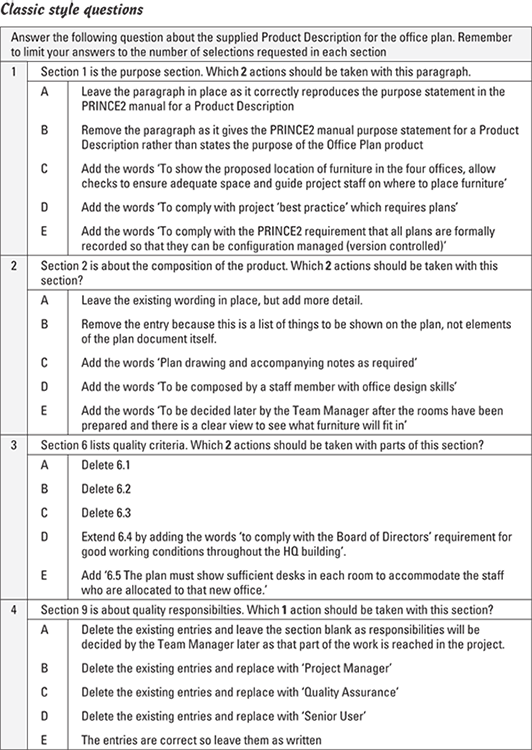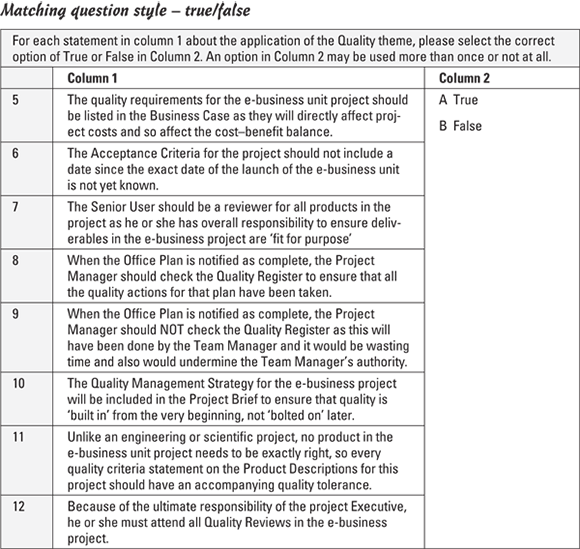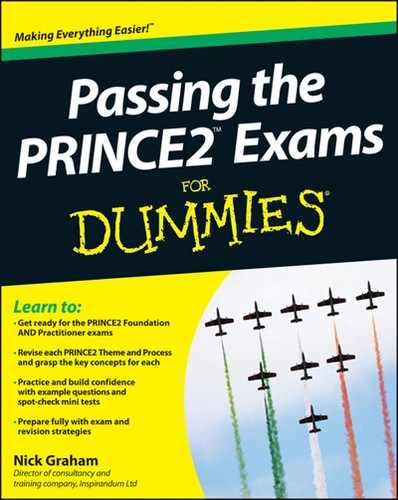Practising With Some Questions
Have a go with some exam-style questions to try your hand at the theme of Quality. Don’t forget that before your exam you can and should also practise with the official sample papers available from the exam authority or through your training supplier. For the Foundation exam though, the official sample papers won’t help much until you have all of the method under your belt, because the questions cover subjects in random order. In this chapter, you have ten Foundation-level questions solely on Quality; what joy.
Foundation-level questions
Try to answer these questions in eight minutes, without looking at any reference material. If you don’t know the answer, then guess; after you’ve been studying PRINCE2 for a while, surprisingly often your gut reaction is correct. For more on exam technique, including more on how to set about guessing, see Chapter 2.
1. It’s important to think through and record how a project will achieve its required quality level. Which product records that detail in PRINCE2?
![]() a) Quality Plan
a) Quality Plan
![]() b) Quality Management System (QMS)
b) Quality Management System (QMS)
![]() c) Project Approach
c) Project Approach
![]() d) Quality Management Strategy
d) Quality Management Strategy
2. Which Project Board role is responsible for ensuring that the project delivers things that are fit for purpose?
![]() a) Executive
a) Executive
![]() b) Senior User
b) Senior User
![]() c) Senior Supplier
c) Senior Supplier
![]() d) Programme representative
d) Programme representative
3. In which PRINCE2 product are Customer Quality Expectations first recorded?
![]() a) Project Product Description (PPD)
a) Project Product Description (PPD)
![]() b) Project Initiation Documentation (PID)
b) Project Initiation Documentation (PID)
![]() c) Project Quality File
c) Project Quality File
![]() d) Quality Management Strategy
d) Quality Management Strategy
4. Which phrase completes the purpose statement for the Quality theme? The purpose of the Quality theme is to define and implement the means by which the project will create and:
![]() a) Deliver products that meet the specified quality standards.
a) Deliver products that meet the specified quality standards.
![]() b) Test products to deliver a workable solution that is value for money.
b) Test products to deliver a workable solution that is value for money.
![]() c) Verify products that are fit for purpose.
c) Verify products that are fit for purpose.
![]() d) Assure products that meet the customers’ quality expectations.
d) Assure products that meet the customers’ quality expectations.
5. Which of these is NOT a role on a PRINCE2 Quality Review?
![]() a) Executive
a) Executive
![]() b) Administrator
b) Administrator
![]() c) Presenter
c) Presenter
![]() d) Reviewer
d) Reviewer
6. What name does PRINCE2 give to quality control while a product is still being developed to ensure that quality is ‘built in’?
![]() a) Developer tests
a) Developer tests
![]() b) Pre-emptive quality control
b) Pre-emptive quality control
![]() c) In-process methods
c) In-process methods
![]() d) Live testing
d) Live testing
7. When is the Quality Management Strategy prepared in a PRINCE2 project?
![]() a) During ‘Starting Up a Project’ to form part of the Project Brief
a) During ‘Starting Up a Project’ to form part of the Project Brief
![]() b) At the start of the stage in which the first major specialist product delivery will be made
b) At the start of the stage in which the first major specialist product delivery will be made
![]() c) During the Initiation Stage
c) During the Initiation Stage
![]() d) During the delivery stages when the quality work is underway if it’s then decided that a strategy will be helpful
d) During the delivery stages when the quality work is underway if it’s then decided that a strategy will be helpful
8. Which of these statements are correct?
A. Quality Assurance is from outside the project management team
B. Quality Assurance is part of the project management team
C. Quality Assurance is accountable to the Project Manager
D. Project Assurance reports to the corporate or programme Quality Manager
![]() a) only A
a) only A
![]() b) only B
b) only B
![]() c) B and D
c) B and D
![]() d) A and C
d) A and C
9. When should those attending a Quality Review receive a copy of the product to be reviewed?
![]() a) As soon as the product has been created
a) As soon as the product has been created
![]() b) When the product has been created and handed back to the Project Manager by the Team Manager
b) When the product has been created and handed back to the Project Manager by the Team Manager
![]() c) Before the review, but in good time to send in comments beforehand
c) Before the review, but in good time to send in comments beforehand
![]() d) As part of the introduction at the start of the Quality Review meeting
d) As part of the introduction at the start of the Quality Review meeting
10. Which of these would be a suitable entry in a project’s Acceptance Criteria?
![]() a) The machine modifications must be done quickly to minimise production loss.
a) The machine modifications must be done quickly to minimise production loss.
![]() b) The new system must have 99 per cent availability with 1 per cent maximum down time.
b) The new system must have 99 per cent availability with 1 per cent maximum down time.
![]() c) The stage for this year’s conference should look smarter than in previous years.
c) The stage for this year’s conference should look smarter than in previous years.
![]() d) The new website should include the normal facilities of a modern site.
d) The new website should include the normal facilities of a modern site.
Practitioner-level questions
Have a go with the 12 practice questions and allow yourself 18 minutes after you’ve read through the additional project scenario information. In the exam you’ll have slightly less time, but also only 10 questions. Don’t forget to take on board the original scenario information at the end of Chapter 2.
Product Description – office plan
ID: PD21 Title: Office Plan
1. Purpose: To help understand the detailed nature, purpose, function and appearance of the product.
2. Composition: Desks, side tables, chairs, visitor chairs, cupboards, filing cabinets, carpets, blinds, coat stand (one for each room).
3. Derivation: List of required furniture.
4. Format and presentation: Colour plan on one side of A3 paper, with any accompanying notes single-sided on A4.
5. Development skills required: An understanding of office layout generally, including health and safety aspects, and also an understanding of the communication needs within the new e-business unit.
6. Quality criteria:
6.1 The chairs must be comfortable.
6.2 The plan must be to scale.
6.3 The plan must show the location of all furniture and power and phone sockets.
6.4 The new doorways should be made before new carpets are laid, so that carpets remain clean and are not damaged by debris or made dirty with dust.
7. Quality tolerance: The project must be delivered in no more than six weeks, but could be delivered up to two weeks early, provided that this does not incur extra costs such as overtime payments to get work done faster and so deliver unnecessarily early.
8. Quality method: The plan will be checked against the standard checklist for headquarters offices, and against current legislation for offices, including checking ergonomic factors to ensure that the office will be both comfortable and safe to use.
9. Quality responsibilities:
The check against headquarters standards – Head of Works Department.
Health and safety and ergonomic standards – to be decided later, because the Health and Safety representative has just resigned, and the replacement is not known. It may have to be an external consultant if a new member of staff is not appointed in time.
Warning: There may be errors in this Product Description


Answers to the quick quiz on Quality Review
1. Chair, Presenter, Reviewer, Administrator.
2. Project Manager – as part of Stage Planning for specialist products.
3. The Chair and Administrator both have responsibility for the administrative arrangements.
4. Presenter.
5. Chair.
6. Chair.
7. Administrator.
8. Chair – well, I have to let you relax now and again with an easy one.
9. Presenter.
10. Administrator.
Answers to the Foundation-level questions
1. d. The term ‘strategy’ is a giveaway for any aspect of ‘how’ something will be done, and in the context of PRINCE2 that’s risk, quality, configuration management (actually, how all change will be managed) and communications.
2. b. A programme representative may attend board meetings, but that isn’t a board role and so isn’t defined in PRINCE2 for quality or any other responsibilities.
3. a. The Project Product Description (PPD) is developed early on – in Start Up. [Manual A.21.2]. The Customer Quality Expectations will go on to be included in the Project Initiation Documentation (PID), but the question specified ‘first recorded’. By the way, in PRINCE2 there’s no such thing as the Project Quality File. There are quality records, and while they may go into a file, that file isn’t a PRINCE2 product.
4. c. Oh dear, they all sound so plausible don’t they? That’s why you need to be familiar with the purpose statements. [Manual 6.1]. Don’t get excessively worried though. If you’re strong across everything else and lose a mark or two on purpose statement questions you won’t be in danger of failing. There’s a balance to strike in revision, and your time may be better invested in places other than purpose and objective lists.
5. a. Don’t confuse the ‘Chair’ role of the Quality Review (QR) with the chair of the Project Board. The Chair of a QR is someone with meeting skills.
6. c. More rote learning of terminology, I’m afraid, although this term is more readily understandable – and so memorable – than some others in the Quality theme.
7. c. The preparation of the strategy is covered by the process Initiating a Project, which in turn is part of the work done in the Initiation Stage.
8. a. Quality Assurance is from outside the project, while Project Assurance is inside the project and accountable to the Project Board – or board members do it themselves. Project Assurance is independent of the Project Manager, but Quality Assurance is independent of the whole project, including its Project Board.
9. c. Comments can be sent in before the review to be put on the agenda for discussion. That means people must get the product in good time.
10. b. Acceptance Criteria must be measurable, and the PRINCE2 manual gives examples. [Manual 6.3.1.2, P2FD Ch13 Specifying Criteria for Project Acceptance]. This question picks up on the ‘availability’ example.
Answers to the Practitioner-level questions
Classic-style questions
1. B and C. The purpose statement simply explains why the product is needed in the project.
2. B and C. It’s easy to lose focus on the product. If you’re confused, think about holding the finished product in your hand or, if it’s too big for that, looking at it. What is the product itself made up of? What are its component parts?
3. A and E. Actually 6.4 is wrong too, so you wouldn’t choose answer ‘D’ to extend it.
4. E. As in other chapters of this book, I’ve been unfair to you by switching the number of required answers part way through the block of questions. In the Practitioner exam, so far anyway, within a set of classic-style questions you’ll always be asked for the same number of answers for each question. That number may be one or two, and hasn’t yet been more (to my knowledge and recall). The rather sneaky switch here is to emphasise that you must stay vigilant to pick up on the number of answers you’re being asked for. If you’re asked for one answer but you select two, your answer will be invalidated. Similarly, if you’re asked for two but only put one answer, your answer will be invalidated.
Matching-style questions – true/false
Don’t expect true/false questions to be simple in the Practitioner-level questions. Some of them can dive deep into the method, and you require a really good understanding of PRINCE2 to answer them.
5. B. Yes, costs are in the Business Case, but there’s no requirement to list out the quality elements in depth. That would make the Business Case excessively detailed.
6. B. A project of this sort should have an end date, irrespective of whether the launch date of the e-commerce unit is fixed. Remember that the Project Plan needs to be drawn up during Initiation, and that should show the expected duration. If the duration of the project fits with the launch date of the e-commerce unit, well and good. If it’s then decided that the e-commerce unit will be launched earlier, and therefore the project needs to deliver earlier, this will come under the project’s change control to decide how to speed things up.
7. B. Total nonsense; the Senior User is not involved in the day-to-day work of the project, and testing is day-to-day work. This question is to reinforce two important points. First, Project Board members are part of the ‘management’ of the project and don’t do day-to-day quality work. And second, Quality Review (QR) is just another sort of test – one of the sorts you might apply to a document. If you’re still confused by this, imagine another sort of test such as checking a computer program. Would you expect to see Project Board members sitting at screens checking programs against expected results as part of their standard responsibilities? Don’t think of QR as anything more than a type of quality control – a test – because that’s all it is. That’s not to say a QR isn’t valuable, it’s just to clarify what it is.
8. A. Yes, the Project Manager should be sure that the quality has been delivered. That check of the register takes moments and is in addition to the check made by the Team Manager.
9. B. The reverse of the last question, to be sure you’re clear on the point.
10. B. Don’t confuse the comprehensive Quality Management Strategy produced in the detailed work of Initiation with the quality intentions set down in Start Up in the Project Product Description (PPD).
11. B. No, and in projects the criteria with a tolerance are likely to be a minority. Be careful here, because some people go a bit overboard with tolerances, and that may be reflected in any training material you have if you’re on a PRINCE2 course. Don’t fall into the trap of thinking that everything must have a tolerance. For example, if I want a text document to go in a standard physical file, I’ll specify that it must be printed on A4 paper. That’s it – no debate. I don’t want it smaller and I don’t want it larger. Am I really that fussed, and would it be such a problem if it was A3 or A5? Yes, it would be a problem, so print the wretched thing on standard A4 and let’s get on with the project!
12. B. No, the role of the Executive is not involved in the QR of specialist products. The person who is the Executive may also be a reviewer for some specialist products where he or she has expertise. However, the person is a reviewer because of his or her expertise, and in the role of reviewer, not because he or she is the Executive.
